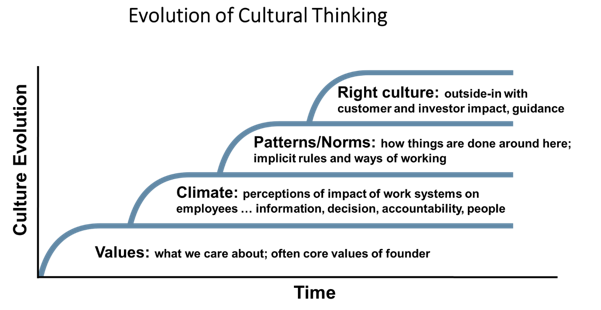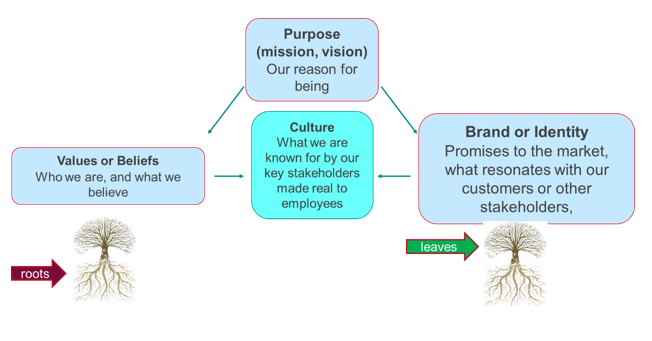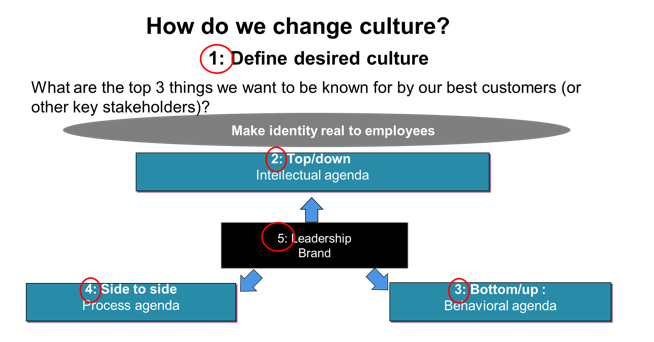In this article, I have solicited the views of top thinkers in the field of organizational culture. They shared with me their opinions on organisational culture, the best approach to change organizational culture, and why culture change often fails. The top thinkers are:
Dr. Naome Stanford - Organisation Design Author and Consultant
1. What is organisational culture?
There’s no simple answer to this question. There are multiple ways of thinking about organisational culture, which has given rise to multiple definitions of it ranging from ‘the way we do things around here to elaborate paragraphs that include behaviors, values, assumptions, norms, and expectations. I’m of the view that there is no singular organizational culture. An organization is similar to a climate zone in that, within a recognizable range/geography, it encompasses multiple weather patterns that vary from location to location and day to day. Organizations comprise multiple cultures within recognizable parameters.
2. What is the best approach to transform organizational culture?
People often talk about transforming the culture, but I don’t think it is possible to do that in any ‘quick fix’ way. On a pottery wheel, you can take a lump of clay and transform it into a beautiful vase or other objects within a short space of time. Culture is not a thing like that. It is a complex, constantly emerging, shifting pattern that never holds still, more like winds or clouds. The best way to ‘transform’ the culture is to accept that you can’t. What you can do is take actions that may serve to change the patterns of it.
I’ve found that Johnson and Schole’s cultural web can help. It looks at stories, rituals/routines, symbols, power structures, control systems, and organizational structures. So you can, for example – listen to the stories being told in and about the organization, try telling different stories. Look at the power structures and see if any are restricting cultural movement and so on. Look at the symbols – change them. I once worked in an organization that had photos of the 12 (white, male) members of the executive team in the reception area. Part of the organizational rhetoric was about everyone being valued. Believing in the power of symbols, I suggested that we take down the pictures of the 12 executive team members and replace them with a photomontage of the entire workforce if this was the case. My suggestion was not accepted, but consider the impact of different visual symbols as reflectors of culture in practice rather than culture in rhetoric.
I use the Johnson and Scholes web because culture is often seen simply as beliefs, behaviors, or values. Still, these are shaped by control, power, and organizational systems, which are part of the culture. Suppose you consider the culture of responsibly driving a car on the road. Your driving ‘culture’ is shaped by road signage, enforceable speed restrictions, road layout, etc. The driving cultures vary by country depending on the systems which shape driver behaviour and also on the way certain driving apps are configured. Cultures are shaped in many different ways and are, as I said, continuously emergent, shaping and being shaped by their context. They are not ‘transformable’ in any magical sense of the word.
3. Why is it that most organizational culture transformations projects fail?
They don’t fail in a complete sense. Organizations have a culture regardless of any ‘transformation’ project. A project may not achieve what it is intended to achieve, but that isn’t the same as ‘failing’. To look at culture change don’t have a ‘project’ instead consider it as an ongoing wicked problem, and keep on using some of the techniques of that, including:
- Recognizing that developing ‘solutions’ will only help us understand the problem better. It won’t ‘solve’ the problem.
- Using collaborative strategies with a win-win style
- Practicing holistic thinking rather than linear or mono-dimensional thinking
- Redefining ‘success’ is no longer doing things in the right order but rather doing enough of the right things simultaneously.
- Identifying the many possible entry points for interventions, launching multiple parallel interventions, and learning in ‘real time’ to ensure the appropriate sequence and mix of activities.
- Accepting that solutions are not right or wrong. They are simply better/worse or good enough/not good enough. (The determination of solution quality is not objective.)
Related: Ten 10 Reasons Why Organisational Change Fails
Dave Ulrich - Speaker, Author, Professor, Thought Partner on HR, Leadership, and Organization
1. What is organizational culture?
Culture is not a “new” topic. In the book Culture: A Critical Review of Concepts and Definitions, anthropologists Kroeber and Kluckhorn identified 164 different definitions of “culture” in 1952. We have seen the concept of culture evolve through four definitions in organization settings (see figure)

1. Values and behaviors inside the organization “roots of the tree.”
2. Climate as evidenced by practices around information, people, decisions, etc.
3. Norms and patterns that shape unconscious bias
Each of these three focuses inside the organization.
4. Outside in, culture is seen as the firm’s identity in the mind of the key customers and other external stakeholders, e.g., “the leaves of the tree.”
This fourth wave defines culture more in terms of how internal values create value in the marketplace. It links culture to purpose from the outside in:

2. What is the best approach to transform organizational culture?
We have identified a five-step process for changing culture:
- Define the desired culture outside/ in terms of identity in the marketplace (see above)
- Implement top/down intellectual agenda with communication and ideas
- Engage a bottom/up behavioral agenda by asking employees to define their behaviors relative to the desired identity
- Design a side to side process agenda by adapting governance process (staffing, training, paying, etc.) to the new culture
- Ensure a leadership agenda by shaping a leadership brand inside consistent with the firm brand outside.

3. Why is it that most organizational culture transformations projects fail?
We have identified seven common causes of change failures that, once identified, can be faced and overcome. These seven factors become a pilot’s checklist of change disciplines to implement a change of culture or another initiative.

Linda Holbeche - Co-Director, The Holbeche Partnership, Adjunct Professor, Imperial College Business School and Visiting Professor, City of London Business School.
1. What is culture?
Beyond the usual “the way we do things around here” or “the way we think about the way we do things around here”, I quite like the following definitions:
“…a system of shared meaning held by members, distinguishing the organization from other organizations” (Martin and Martins, 2003) and “…the sum total of all the shared, taken for granted assumptions that a group has learned in coping with external tasks and dealing with internal relationships” (Edgar Schein, 2004).
2. The best approach to transforming organizational culture
This is a vast topic in its own right. I think there are necessary ingredients - genuine top leadership support and ownership, two-way communications, opportunities for participation/awareness-raising, methods of engaging the grassroots in the emergence of new practice. Usually, it helps if there is a strong reason for wanting to change the culture (a burning platform), but it’s important that people recognize/ are exposed to the need for change, or the forces in favor of the status quo will prevail. I quite like the approach of Quinn, who advocated ‘logical incrementalism’ - where a small change, e.g. to a work process, can lead on to other small changes that, before you know it, have changed the culture, but without a revolution.
3. Why do most organizational culture transformation projects fail?
Most of the reasons linked to the typically top-down nature of many cultural transformation projects where change is done ‘to’ people rather than done’ with’. Many major change projects are approached largely from the technical perspective on change rather than the human, so if people’s questions are not answered they tend not to commit to new ways of working. Especially if their job is affected negatively by the change, and if people have no chance to have their voices heard, you can expect resistance. If resistance forces grow, it’s unlikely that transformation efforts will achieve their preconceived desired outputs. Marshak points out that organizations tend to act more as political collectives where power and politics are more than reason and logic determining what happens.
Ideally, of course, cultural transformation would lead to high performance. If you want this, it’s best to approach transformation by creating a social movement for change. To achieve this, it’s important to actively involve and encourage people in the change process and consider their ideas. That way, people are more likely to feel motivated by the change and want to play their part. I quite like the phrase that ‘Energy, not time, is the fuel of high performance’ (Loehr and Schwartz, 2003, The Power of Full Engagement).
Glenda Eoyang -A bit of a preface:
I founded and continue to work in the field of human systems dynamics (HSD). We use principles and practices from complex adaptive systems sciences to see patterns in human systems at all scales, make sense of them in useful ways, and take individual and collective action to help people thrive. You can find out more about our work at www.hsdinstitute.org and Adaptive Action:
1. What is organizational culture?
Organizational culture is a pattern that emerges across the social system from the behaviors and interactions of individuals and groups within it. At every moment, an individual’s actions reflect others’ actions and influence the actions of even more others. Given the drive for human beings to belong, and given that belonging depends on similarity and connection, each person represents the whole, reflecting the common and coherent actions of individuals over time.
Based on principles of fractal generation and self-organizing systems, we understand that a shortlist of simple rules influences individuals’ choices and actions. The rules may be implicit or explicit. Some or all may know them. They can be designed and implemented by leadership. Still, more often, they evolve to respond to immediate challenges and the underlying beliefs, values, and needs of employees at all levels of the organization.
Simple Rules that determine cultural patterns are few (usually fewer than seven), begin with verbs (focus on action rather than talk), apply to everyone in the system (open to interpretation, depending on roles and responsibilities.) For example, these are the Simple Rules of the human systems dynamics (HSD) community. Each of our 900 Associates worldwide is expected to live these out in their personal and professional lives. Can you imagine the culture that has evolved in our organisation and our community?
- Stand in inquiry
- Search for what’s true and useful
- Find the energy in difference
- Zoom in and zoom out
- Connect with stories and impacts ï‚· Celebrate life!
These rules inform all our work, from marketing through research and development and conflict resolution. As a result, we generate a system-wide pattern, which we understand to be “culture.”
2. What is the best approach to transform organizational culture?
To transform culture, the rules have to change. In our work, this is a four-step process.
Step 1. Make the current rules explicit. Through observation, reflection, and dialogue, people recognize and agree on the rules they follow that shape cultural patterns. This may begin with the C Suite or on the shop floor. Still, ultimately all groups across the organization recognize the current rules and acknowledge how they play out every day to influence the emerging culture.
Step 2. Define the desired cultural patterns. Individual reflection and group dialogue lead to a shared understanding of the most desirable future. Recently, we have used a variety of futuring processes to help groups imagine cultural patterns for today and into the unknowable future. The description doesn’t need to be a carefully crafted “vision statement.” It can be a collection of statements, words, symbols, or stories that capture the cultural patterns of a most productive future.
Step 3. Adapt the rules to generate the patterns you desire. Review the current Simple Rules and ask, “What patterns—good and bad—are these rules generating for us?” With that in mind, ask, “What is the smallest change we can make in these rules that will generate our desired pattern?” This inquiry begins from the current rules because they are so ingrained they will deny, resist, and undermine any efforts at change. The change must be small to reduce the resistance and focus on differences that will constitute significant transformations.
One example from the evolution of the HSD Simple Rules shifted “Tell the HSD Story” to “Share your HSD story.” The first generated conflict about which HSD story was best and competition for who could tell it most effectively. The second makes each person accountable for creating their own story and for listening to the stories of others.
Step 3. Embed the Simple Rules into policies, procedures, and practices. Each person reflects on their roles and responsibilities and considers how they can more effectively live into the Simple Rules. Interpretations vary, and dialogue strengthens individual and shared understanding. Over time, the patterns of culture shift as the new Simple Rules take effect.
Step 4. Review and revise the rules regularly. As patterns become entrenched, some old rules are no longer needed. As the environment shifts, other rules may become necessary. Periodic reviews keep the rules—and the culture—lively as they inspire continuing conversations about culture and behavior.
3. Why is it that most organizational culture transformations projects fail?
We see several sources of failed organization culture transformations.
There are few practical, valid, or reliable theories that explain the realities of organisational culture. Most traditional culture models are based on power relationships, mechanistic cause, and effect, psychological principles, or spiritual transformation. They are not adaptable to the needs and histories of particular organisations, and they don’t translate effectively into the choices of individual actors across the organisation. They focus on changing hearts and minds, not behaviours and patterns.
They focus on the talk more than action. A tremendous effort goes into the wording of visions and values. Resources are invested in fancy graphics and videos, and exhortations. Everyone can talk about the culture of the future, but no one knows what to do. The result is cynicism, in addition to unchanging culture.
The process begins and ends in the C Suite. Executives see different patterns than others in the organisation. Their restricted view makes it impossible for them to be realistic about what is now and possible in the future. True change must begin with a clear-eyed understanding of what exists and how current conditions are serving a shared purpose. A true and useful picture of cultural patterns requires the intelligence of all levels and all parts of the organisation—and dialogue to find the energy in differences as they emerge.
Those who benefit from the current “negative” patterns are given too much power in the transition. The behaviours of individuals are purposeful. They make choices to optimise benefits for themselves and their friends. They lock in patterns that may have worked yesterday or that serve local needs without considering future challenges or other parts of the system. All of those patterns are locked in—solidified in habit and accepted practice. Before change can happen, power must shift. The alternative actions contributing to the new pattern must be appreciated and incentivised consistently and publicly to re-focus power that amplifies positive and marginalises negative patterns of behavior and emerging culture.
In spite of the best intentions, most cultural transformation efforts are short on reliable theory and short on effective practice. We believe that complex adaptive systems theory, through the principles, models, and methods of HSD, provides a practice that is both consciously coherent and actionable by everyone in the system to create new patterns of organisational culture.
Memory Nguwi is an Occupational Psychologist, Data Scientist, Speaker, & Managing Consultant- Industrial Psychology Consultants (Pvt) Ltd, a management and human resources consulting firm. https://www.thehumancapitalhub.com email: mnguwi@ipcconsultants.com or visit our website at www.ipcconsultants.com

.avif)

